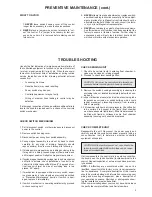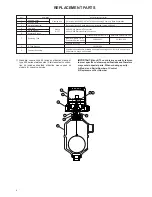
4
Periodic inspections are a necessary means to keep your Magnetrol level control in good working order. This control
is, in reality, a safety device to protect the valuable equipment it serves. Therefore, a systematic program of
“Preventive Maintenance” should be implemented when control is placed into service. If the following sections on
“What to Do” an “What to Avoid” are observed, your control will provide reliable protection of your capital equipment.
PREVENTIVE MAINTENANCE
WHAT TO DO
1.
Keep Control Clean
Be sure the switch housing cover is always in place on
the control. This cover is designed to keep dust and dirt
from interfering with switch mechanism operation. In
addition, it protects against damaging moisture and
acts as a safety feature by keeping bare wires and ter-
minals from being exposed. Should the housing cover
become damaged or misplaced, order a replacement
immediately.
2. Inspect Switch Mechanisms, Terminals and
Connections Monthly
– Mercury switches may be visually inspected for short
circuit damage. Check for small cracks in the glass
tube containing the mercury. Such cracks can allow
entrance of air into the tube causing the mercury to
“oxidize”. This is noticeable as the mercury will
appear dirty and have a tendency to “string out” like
water, instead of breaking into clean round pools. If
these conditions exist, replace the mercury switch
immediately.
– Dry contact switches should be inspected for exces-
sive wear on actuating lever or misalignment of
adjusting screw at point of contact between screw
and lever. Such wear can cause false switch actuat-
ing levels. Adjust switch mechanism to compensate
(if possible) or replace switch.
DO NOT operate your control with defective maladjusted
switch mechanisms (refer to bulletin on switch mechanism
furnished for service instructions).
– Magnetrol controls may sometimes be exposed to
excessive heat or moisture. Under such conditions,
insulation on electrical wires may become brittle,
eventually breaking or peeling away. The resulting
“bare” wires can cause short circuits. Check wiring
carefully and replace at first sign of brittle insulation.
– Vibration may sometimes cause terminal screws to
work loose. Check all terminal connections to be cer-
tain that screws are tight.
– On units with pneumatic switches, air (or gas) oper-
ating medium lines subjected to vibration, may even-
tually crack or become loose at connections causing
leakage. Check lines and connections carefully and
repair or replace, if necessary.
NOTE: As a matter of good practice, spare switches should
be kept on hand at all times.
3. Inspect Entire Unit Periodically
Isolate control from vessel. Raise and lower liquid level
to check for switch contact and reset.
WIRING (cont.)
Set screw
Set screw
Locking screw
Set screw
Position
screw
CAUTION:
- DO NOT attempt to reposition NEMA 4 /
NEMA 7/9 housings without loosening the
set screws; CENELEC/BASEEFA housings
MAY NOT BE REPOSITIONNED. ALWAYS
retighten set screw(s) after repositionning.
- DO NOT attempt to unscrew cover of CEN-
ELEC/BASEEFA housings before loosening
locking screw in base of housing. ALWAYS
retighten locking screw after replacing cover.
Figure 4c
Figure 4a
Figure 4b
NEMA 4x
NEMA 7/9
CENELEC/BASEEFA
OBSERVE ALL APPLICABLE ELECTRICAL CODES AND PROPER WIRING PROCEDURES


























